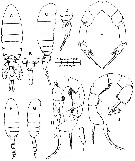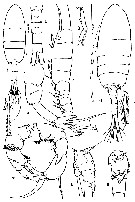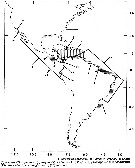|
|
 |
|
Calanoida ( Order ) |
|
|
|
Diaptomoidea ( Superfamily ) |
|
|
|
Pseudodiaptomidae ( Family ) |
|
|
|
Pseudodiaptomus ( Genus ) |
|
|
| |
Pseudodiaptomus marshi Wright, 1936 (F,M) | |
| | | | | | | Syn.: | Pseudodiaptomus culebrensis : Collado & al.,1984 | | | | Ref.: | | | Wright, 1936 ( p.13, figs.F,M); 1937 a (p.159, 161, 162, figs.M); Dussart & Fernando, 1985 (p.39, figs.F,M, Rem.); Walter, 1986 (p.131); 1986 a (p.503, fig.1: zoogeogr.); 1987 (p.366); 1989 (p.604, Redescr.F,M, figs.F,M; Rem.); Bradford-Grieve & al., 1999 (p.884, 953, figs.F,M, p.876: chart) |  issued from : T.C. Walter in Bull. Mar. Sc., 1989, 45 (3). [p.605, Fig.8]. Female: A, habitus (dorsal); B, last thoracic segment 5 and urosome (dorsal); C, habitus (lateral right side); D, last thoracic segments and urosome (lateral left side); E, P5 (anterior view). Male: F, habitus (dorsal); G, idem (lateral right side); H, P5 (posterior view); I, exopod 2 of left P5 (lateral view); J, P5 (anterior view).
|
 issued from : S. Wright in Ann. Acad. Brasileira Sci., 1937, 9 (2). [Pl.1, Figs.6, 7]. Male: 6, exopodite 1 of right P5; 7, idem (lateral view).
|
 issued from : S. Wright in Annaes. Acad. bras. Cienc., VIII (1), 1936. [Pl.III, Figs.1-5, 7 (no 6 as in legend)]. Female: 2, right P5; 5, genital segment (from left side); 7, posterior part of thorax and urosome (dorsal). Male: 1, right A1 (segments 9 to 15; setae and aesthetascs omitted); 3, P5; 4, right P5 (1st segment of exopod, from right side).
|
 issued from : B.H. Dussart & C.H. Fernando in Crustaceana, 1985, 50 (1). [p.40, Fig. 1-9]. Male (from E Costa Rica): 1, habitus (dorsal) with detail ao a furcal seta; 2, urosome (ventral); 3, last segments of right A1; 4, right A1 (middle part); 7, P5 (posterior view). The last thoracic segment has a tuft of hairs on its left side only; the remaining cephalothoracic segments are hairless. 2nd urosomal segment has its distal edge surrounded with teeth (or is scalloped) ventrally and laterally, but it is smooth dorsally; the two succeding segments are scalloped all aroud. The caudal rami are symmetrical and their setules are lacking in the proximal third, while before the beginning of the setulose part there is an apparent swelling. The right A1 possesses a comb of spinules before the geniculation (antepenultimate segment); the 9th segment has a very long spine Female (from E Costa Rica): 5, P5 (lateral); 6, habitus (dorsal) with detail of portion of a furcal seta; 8, genital segment (lateral); 9, same (ventral). The last thoracic segment is asymmetrical. The genital segment is ornamented with distinct patches of hairs, its right side possesses a ciliated knob, also near the distal margin of the segment and dorsally there are 2 symmetrical hairs; ventrally, the genital area is asymmetrical and triangular; the next segment has a tuft of long hairs dorsally and 2 symmetrically placed hairs proximally. The caudal rami are somewhat asymmetrical. A1 generally reach the last urosomal segment. P5 symmetrical. The right egg-sac is smaller than the left.
| | | | | Compl. Ref.: | | | Sewell, 1948 (p.452); Dussart & Defaye, 1983 (p.33); Suarez-Morales & Gasca, 1998 a (p.111); Krumme & Liang, 2004 (p.407, tab.1); Medeiros & al., 2006 (p.243, Table 1); Sterza & Fernades, 2006 (p.95, Table 1, occurrence); Morales-Ramirez & Suarez-Morales, 2008 (p.514); Magalhaes & al., 2009 (p.187, Table 1, %); Medellin-Mora & Navas S., 2010 (p.265, Tab. 2); Magris & al., 2011 (p.260, abundance, interannual variability); Magalhaes & al., 2011 (p.1520, seasonal abundance); Almeida LR. & al., 2012 (p.13, Table 1, abundance); Garbosa da Costa & al., 2013 (p.756, Table 1, abundance vs tide); Fuentes-Reinés & Suarez-Moeales, 2015 (p.369, Table 1, Rem. p.373); Atique & al., 2017 (p.1, Table 1, fig.8, Rem.: p.10). | | | | NZ: | 3 | | |
|
Distribution map of Pseudodiaptomus marshi by geographical zones
|
| | |  issued from : T.C. Walter in Bull. Mar. Sc., 1989, 45 (3). [p.625, Fig.18]. issued from : T.C. Walter in Bull. Mar. Sc., 1989, 45 (3). [p.625, Fig.18].
Map of American continents showing the zoogeography of Pseudodiaptomus species. |
 Issued from : A. Magalhaes, D.S.B. Nobre, R.S.C. Bessa, L.C.C. Pereira & R.M. da Costa in J. Coastal Res., 2011, SI 64. [p.1522, Fig.2]. Issued from : A. Magalhaes, D.S.B. Nobre, R.S.C. Bessa, L.C.C. Pereira & R.M. da Costa in J. Coastal Res., 2011, SI 64. [p.1522, Fig.2].
Seasonal variation in the abundance, biomass and productivity of Pseudodiaptomus marshi in the Taperaçu estuary (00°55'06.8''S, 46°44'00''W) in July (rainy season) and October (dry season), 2004, during spring tides (flood and ebb periods), at 3-hour intervals over 24-hour period. with a plankton net (300 µm mesh aperture). |
| | | | Loc: | | | Brazil (Pomonga River, Vitoria Bay, Guarairas Lagoon, Mucuri estuary, Curuça estuary, Taperaçu estuary, Caeté Estuary, Amazon estuary), Trinidad Is., Caribbean Colombia (Tayrona), Belize, Colombia (Laguna Navio Quebrado), E Costa Rica (Limon estuary, Caribbean Sea), Acapulco (Mexico, Pacific) | | | | N: | 15 | | | | Lg.: | | | (950) F: 1,29-1,51; M: 0,95-1,06; {F: 1,29-1,51; M: 0,95-1,06} | | | | Rem.: | Brackish, estuary, mangrove.
Incomplete data.
In Americanus species group (pelagicus subgroup) after Walter & al. 2006, p.203.
According to Dussart & Fernando (1985, p.41) the fact that this species was found on the Pacific as well as yhe Atlantic coast in Central America, shows that this brackishj water species was existiting already at the time the two continents, i.e. Nortg and South America, were still separated by a Caribbean plate. This plate has been drifting from the Pacific Ocean to the Atlantic during Eocene (50 million years ago) or at least from the early Miocene (20 million years ago), and is still drifting today (with a motion to the east of about 1 cm/yr (cf. Sykes & al., 1982). | | | Last update : 12/02/2021 | |
|
|
 Any use of this site for a publication will be mentioned with the following reference : Any use of this site for a publication will be mentioned with the following reference :
Razouls C., Desreumaux N., Kouwenberg J. and de Bovée F., 2005-2025. - Biodiversity of Marine Planktonic Copepods (morphology, geographical distribution and biological data). Sorbonne University, CNRS. Available at http://copepodes.obs-banyuls.fr/en [Accessed November 30, 2025] © copyright 2005-2025 Sorbonne University, CNRS
|
|
 |
 |









